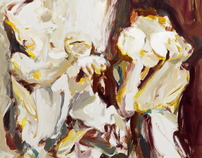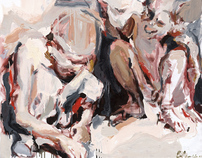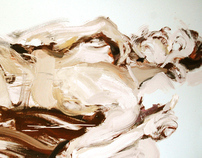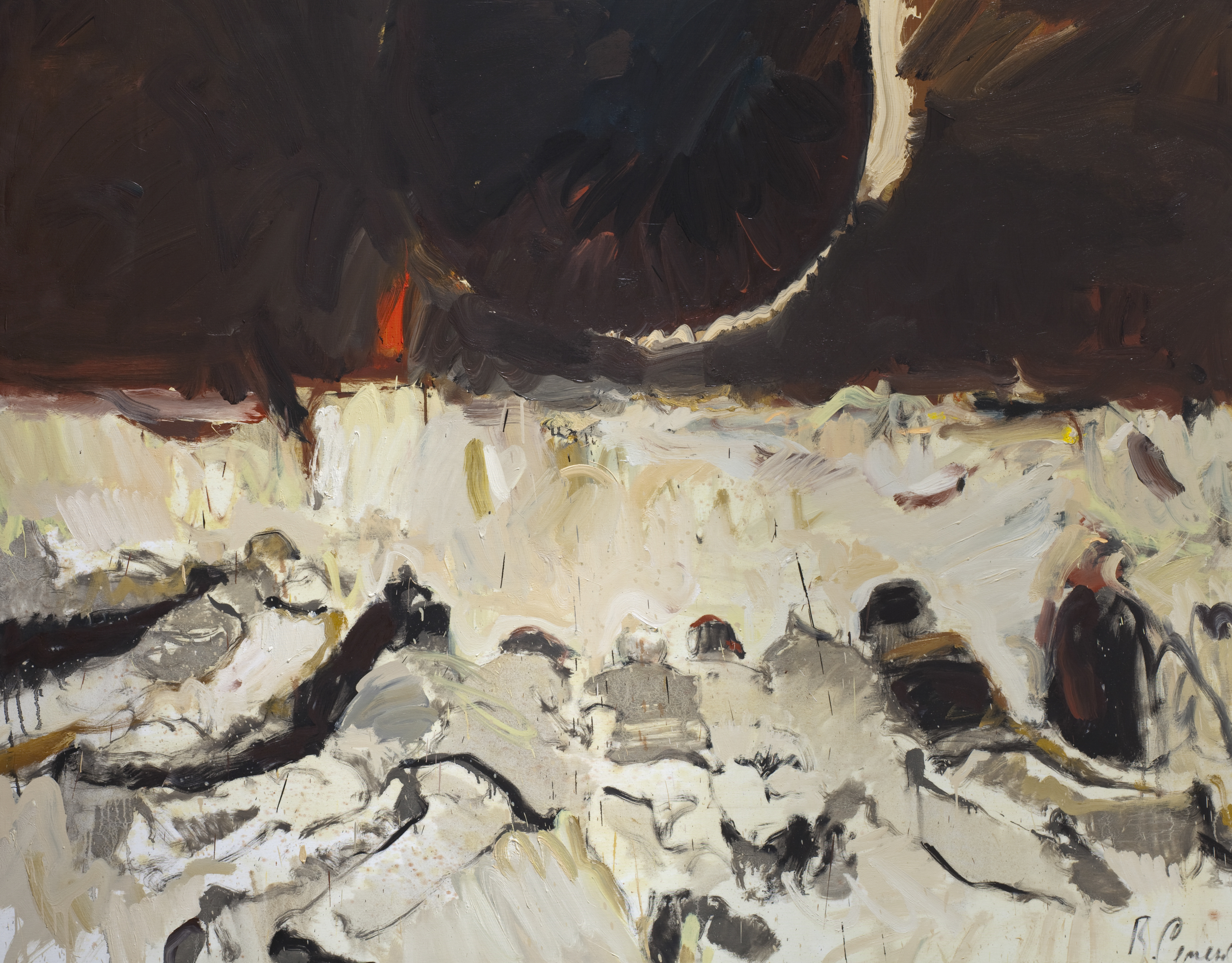When contemporary art studies put a question on the art agenda about the newest forms of expression, it implies or suggests that contemporary artists rarely use painting as a working language; and that to create their works, they use other means of expression that modern audiences understand quite well. Can contemporary art speak the language of painting? Or, can the reality ofthe third millennium express itself, using this language, or become apparent init? The answer to these questions is not so obvious, and even their formulation may seem absurd to representatives of the old academic school of art history.
In and of itself, the realization of a painting cannot be the goal of creativity; it is art itself which so decrees, in accord with the task that the artist decides on Art exists outside norms and accepted rules – but as soon asthe artist starts to say or do anything, his acts lay the foundation of his personal grammar. In that moment of creativity, which almost always coincides with the artist’s original intent and, in reality, first shapes the work, the artist becomes an agent of the languagethat informs his message, even before he knows if anyone will choose tounderstand or master it (which may be logical – or not).
Why do we continue to talk about painting? Why do galleries (or, today’s so-called “participants in the process”), dedicated as they areto modernity, continue to show an artist's work while insisting upon a language which relates to the traditional Russian school of painting?The answer to this question requires an understanding of what modern painting means.
This artistic language, which allows us to speak about the private spaces of modern man, is an absolute language: It is not about anything in particular, and neither describes nor depicts. In any case, neither the image nor the story is the object of theartistic act. The artist’s goal is man’s emergence. Action itself, that is, a movement that reflects a living human presence, becomes the painting’scontent. Man is cut off from the trappings of modernity and remains without the points of referencethat might offer him culture at the beginning of the third millennium. He needs to lay a foundation and framework in himself. And this act is not just symbolic, as it isimpossible to be content merely as an image of life or a living body. Just as a product cannot be an artistic representation, so too are conversations about art in general far from thereality of artistic production. The work becomes a part of human life and flow, expanding the boundaries of man’s reality and everyday experience. In this way, one may understand Semenskiy’s painting.
Painting is a timeless act wherein the author's attention is concentrated on the moment and its multiple manifestations, on the discontinuity in the densefabric of time. The point is not to generalize about the apparent world or its characteristics. Art does not have to express the conventions of its age. It expresses the spirit of its time, but does not explain it. It is impossible to imagine modern cultureas a monolithic, homogeneous system that speaks in one language. Nor can one not agree with the assumption of a single hierarchy in the language of culture. Perhaps the largest, loosest, and most popular components of such a system appear in the less popular but extremely profound and deeply nuanced demonstration versions of artistic works that appear in the labyrinths of culture. For one reason or another, which we will not discuss here, modern man chooses one language or another to transmit and receive cultural messages. There are cultural spaces that confirm artistic expression, where art exists as part of the entertainment industry or where it exists as part of a production system, with more attention paid to consumption than to the elusive and real worth. Art can comment on socio-political issues, or illustrate and informtoday’s reality; and, although different expressions may still be limited to the format of a newspaper cartoon, they are quite marvelous. This article is not about the technology of works of art, but rather about the always meaningful patterns that relate to linguistic forms of culture, one of which is painting. Painting leads to the practice of modern culture, because it puts a finger on the essence of meaning in language, whichis in all-too-short supply these days. The art of recent decades has been dominated by “simulationism,” which today we understand as a practice that mocks art itself – and its customers.
Painting provides modern man with an opportunity to speak as if he were talking with his nearest and dearest, to change the vocabulary and tone of language to suit his understanding and personal experience of events. Naturally, this ability is not limited to issuesof global importance, but speaks rather of modern man’s ability to free himselfof semantic, linguistic and cultural cliches. It is important for modern man to become himself and tolive his own life. He is therefore unafraid of banalities; and if this calls to mind the well-known dialogue from “Pokrovsky Gate,” (namely thereply, ”But what’s it to you?”), he readily accepts this indebtedness and counts it as just another reason to keep working.
It is obvious that painting today has become neither a popular language of cultural exchange nor has it become a dead language. The scale of its use lags far behind not only the music, dance, and theater, but also pictures, video or installations. After visiting exhibitions of contemporary art, modern man comes again to museums and exhibitions to find paintings. Is it just a coincidence that the explosive popularity of the Pablo Picasso exhibit at the Pushkin Museum of Fine Arts in Moscow coincides with the opening of the Semensky exhibition (which, incidentally, opened on the same day)? Doesn’t it seem as if the work ofour contemporaries may also be seen in Picasso’s works? Of course, it may, as the play of space and the complicated metaphors in those works easily fall into the flow of modern life itself.
In the works of Vladimir Semenskiy, mythological subjects are combined to appear with new qualities. These appear when the artist states something that was known not to him alone but to everyone, and for a very longtime. They re-appear – refreshed – when the artist shows us something we already knew and we begin to remember what was in Botticelli's Venus, Rembrandt’s Danae, and Serov’s Europe. Now we remember what happened to them, and it’s astrange sensation, a bit funny and scary at once, like contemplating a drunken woman; especially as, at the same time, it feels like floating on the surface of the waves and kneeling on the shore. There is a sense of disjointedness, as if the old lady had nothing more to say about beauty or love or pain; or how life has broken her. Through today's pictures,we become aware of the spirit of the old gods and how they continue to live and change. All of these ideas lead to along conversation, undertaken not to discover and prove something new, not to explain them in modern language, but rather to continue their profound reticence. This connection to those meanings lives only, it seems, thanks to art. I really liked the Minotaur, because of the highly instructive colors – Greek terra-cotta and blood-filled bull's eyes – in which he seems to see his reflection. In these works, there is uncharacteristic emotional depth for contemporary art, and a bitterly ironic tone that make their history especially lively.
Sasha Balashov
In and of itself, the realization of a painting cannot be the goal of creativity; it is art itself which so decrees, in accord with the task that the artist decides on Art exists outside norms and accepted rules – but as soon asthe artist starts to say or do anything, his acts lay the foundation of his personal grammar. In that moment of creativity, which almost always coincides with the artist’s original intent and, in reality, first shapes the work, the artist becomes an agent of the languagethat informs his message, even before he knows if anyone will choose tounderstand or master it (which may be logical – or not).
Why do we continue to talk about painting? Why do galleries (or, today’s so-called “participants in the process”), dedicated as they areto modernity, continue to show an artist's work while insisting upon a language which relates to the traditional Russian school of painting?The answer to this question requires an understanding of what modern painting means.
This artistic language, which allows us to speak about the private spaces of modern man, is an absolute language: It is not about anything in particular, and neither describes nor depicts. In any case, neither the image nor the story is the object of theartistic act. The artist’s goal is man’s emergence. Action itself, that is, a movement that reflects a living human presence, becomes the painting’scontent. Man is cut off from the trappings of modernity and remains without the points of referencethat might offer him culture at the beginning of the third millennium. He needs to lay a foundation and framework in himself. And this act is not just symbolic, as it isimpossible to be content merely as an image of life or a living body. Just as a product cannot be an artistic representation, so too are conversations about art in general far from thereality of artistic production. The work becomes a part of human life and flow, expanding the boundaries of man’s reality and everyday experience. In this way, one may understand Semenskiy’s painting.
Painting is a timeless act wherein the author's attention is concentrated on the moment and its multiple manifestations, on the discontinuity in the densefabric of time. The point is not to generalize about the apparent world or its characteristics. Art does not have to express the conventions of its age. It expresses the spirit of its time, but does not explain it. It is impossible to imagine modern cultureas a monolithic, homogeneous system that speaks in one language. Nor can one not agree with the assumption of a single hierarchy in the language of culture. Perhaps the largest, loosest, and most popular components of such a system appear in the less popular but extremely profound and deeply nuanced demonstration versions of artistic works that appear in the labyrinths of culture. For one reason or another, which we will not discuss here, modern man chooses one language or another to transmit and receive cultural messages. There are cultural spaces that confirm artistic expression, where art exists as part of the entertainment industry or where it exists as part of a production system, with more attention paid to consumption than to the elusive and real worth. Art can comment on socio-political issues, or illustrate and informtoday’s reality; and, although different expressions may still be limited to the format of a newspaper cartoon, they are quite marvelous. This article is not about the technology of works of art, but rather about the always meaningful patterns that relate to linguistic forms of culture, one of which is painting. Painting leads to the practice of modern culture, because it puts a finger on the essence of meaning in language, whichis in all-too-short supply these days. The art of recent decades has been dominated by “simulationism,” which today we understand as a practice that mocks art itself – and its customers.
Painting provides modern man with an opportunity to speak as if he were talking with his nearest and dearest, to change the vocabulary and tone of language to suit his understanding and personal experience of events. Naturally, this ability is not limited to issuesof global importance, but speaks rather of modern man’s ability to free himselfof semantic, linguistic and cultural cliches. It is important for modern man to become himself and tolive his own life. He is therefore unafraid of banalities; and if this calls to mind the well-known dialogue from “Pokrovsky Gate,” (namely thereply, ”But what’s it to you?”), he readily accepts this indebtedness and counts it as just another reason to keep working.
It is obvious that painting today has become neither a popular language of cultural exchange nor has it become a dead language. The scale of its use lags far behind not only the music, dance, and theater, but also pictures, video or installations. After visiting exhibitions of contemporary art, modern man comes again to museums and exhibitions to find paintings. Is it just a coincidence that the explosive popularity of the Pablo Picasso exhibit at the Pushkin Museum of Fine Arts in Moscow coincides with the opening of the Semensky exhibition (which, incidentally, opened on the same day)? Doesn’t it seem as if the work ofour contemporaries may also be seen in Picasso’s works? Of course, it may, as the play of space and the complicated metaphors in those works easily fall into the flow of modern life itself.
In the works of Vladimir Semenskiy, mythological subjects are combined to appear with new qualities. These appear when the artist states something that was known not to him alone but to everyone, and for a very longtime. They re-appear – refreshed – when the artist shows us something we already knew and we begin to remember what was in Botticelli's Venus, Rembrandt’s Danae, and Serov’s Europe. Now we remember what happened to them, and it’s astrange sensation, a bit funny and scary at once, like contemplating a drunken woman; especially as, at the same time, it feels like floating on the surface of the waves and kneeling on the shore. There is a sense of disjointedness, as if the old lady had nothing more to say about beauty or love or pain; or how life has broken her. Through today's pictures,we become aware of the spirit of the old gods and how they continue to live and change. All of these ideas lead to along conversation, undertaken not to discover and prove something new, not to explain them in modern language, but rather to continue their profound reticence. This connection to those meanings lives only, it seems, thanks to art. I really liked the Minotaur, because of the highly instructive colors – Greek terra-cotta and blood-filled bull's eyes – in which he seems to see his reflection. In these works, there is uncharacteristic emotional depth for contemporary art, and a bitterly ironic tone that make their history especially lively.
Sasha Balashov




